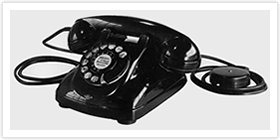Part 5: Postwar efforts to restore the telephone infrastructure
For Japan, a land devastated by the war, the first step to recovery was to reestablish lifelines. OKI made every effort to restore the country's devastated telephone systems. Struggling with material shortages, OKI resumed production of telephone machines and exchanges, playing a major role in the development of the Type-4 Telephone, often said to symbolize Japan's recovery.
Damage to telephone facilities and OKI's efforts
The war greatly damaged the country's telephone facilities; 100% of subscriber telephones were destroyed in atom-bombed Hiroshima, 87% in Tokyo, 99% in Yokohama, and 89% in Osaka. Telephones entirely undamaged by the war were rare in major cities.
With a reawakened sense of mission, OKI, at the frontlines of the country's telephone industry since the Meiji era, began production of telephone equipment alongside efforts to restore its Shibaura factory. As early as January 1946, the year after the war, OKI delivered 500 magnetic telephones to the Telecommunications Agency, the first milestone in the restoration of the country's telephone infrastructure.
These efforts entailed major hurdles. Due to material shortages, the only option was to use products made under provisional standards during the war or other substitutes. Despite the sophistication applied to actual manufacture, many failures and problems were reported to OKI. The factory held troubleshooting meetings twice weekly to inspect materials and discuss design changes. OKI tried to counter unfavorable conditions by performing reviews again and again.
Due to poor equipment and shortages of materials and power, ensuring high quality while immediately meeting growing demands was all but impossible. Eventually, OKI identified a need to produce new types of telephones, a need mirroring the renaissance Japan had now entered, as opposed to mere restoration.
Type-4 Telephone created under an unprecedented development strategy

Type-4 Telephone
In the year after the war, in line with the restoration of the telephone infrastructure, the Telecommunications Agency's Electricity Test Center announced a project to develop a new type of telephone. Four Japanese manufacturers participated in this project, including OKI. (A prototype was later developed jointly by six companies.) This joint project involved an unprecedented total collaboration scheme under which all participants disclosed their patents, factory capabilities, and manufacturing technologies to all other parties to build the prototype. Underpinning these efforts was an intention to strengthen the infrastructure to achieve postwar restoration and a strong commitment to develop Japanese-made telephones at world-class levels.
Often said to symbolize Japan's recovery, the Type-4 Telephone emerged from these efforts. The preceding Type 3 had produced a shrill, unclear, characteristically "telephone" audio quality which made using it awkward, partly due to the poor quality of materials available in postwar Japan.
Development of the new type proceeded on the basis of improved transmitters and receivers, with the explicit goal of improving speech quality. The new model was 30 times more sensitive than the Type-3 Telephone, a model widely used since its adoption in 1933. After much trial and error, in August 1948, the companies succeeded in producing a prototype that met requirements. They were in a position to create a Japanese telephone that would surpass the world standard.
The new telephone featured a novel, streamlined profile, a design developed by Naoki Tominaga, industrial design advisor to OKI, based on the idea of a telephone offering long service life and radiating reliability. The unique body design was the result of a full consideration of productivity and robustness.
Commitment to development and mass production

Telephone mold factory (1959)
In 1949, the project participants launched joint mass production of the Type-4 Telephone for on-site testing. Under its total mobilization program, OKI organized a department to promote the new phone and committed itself fully to mass production of this model. Under the Corporate Reconstruction Act, OKI dissolved itself during this year and established a new company, OKI Electric Industry. Actual mass production trials followed in the subsequent year. With the determination and pride of a leading telephone manufacturer, the new OKI threw itself into development and production.
The new model was mass-produced by all project participants. Some four million units had been produced by 1963, based on orders received from the Nippon Telegraph and Telephone Public Corporation. Of this total, OKI manufactured around one and half million units. Although parts production was divided among the project participants, OKI demonstrated its prowess as the leading telephone manufacturer by producing all its parts in-house.
The Type-4 Telephone was the first of the public telephones widely known as "red telephones." Originally black, it appeared in red from August 1953 for telephones intended for public use, to make it stand out in front of stores. Its popularity soared, as did numbers of users.
Top manufacturers in Japan cooperated in developing the Type-4 Telephone, an effort that strengthened Japan's telephone technologies to world-leading levels. The device symbolized a renaissance in the telecommunications industry and portended an era of high growth.